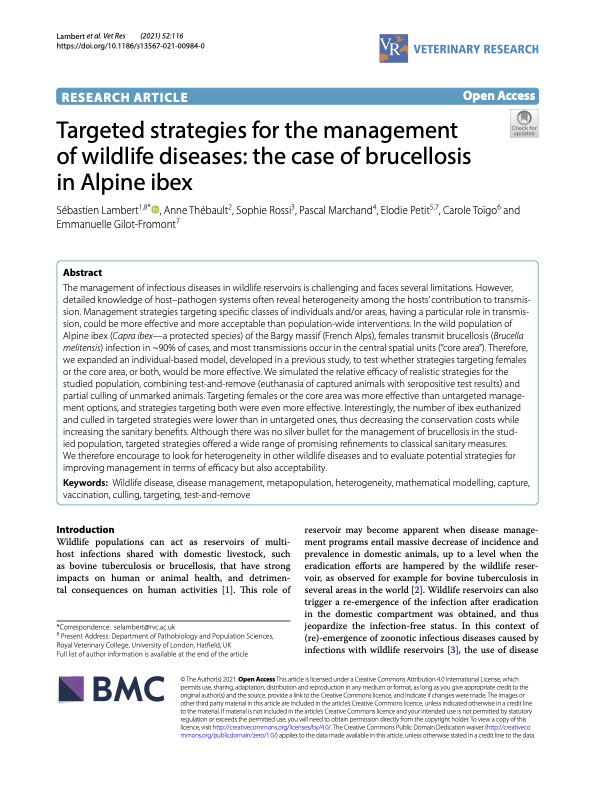S Lambert
Targeted strategies for the management of wildlife diseases: the case of brucellosis in Alpine ibex
Lambert, S; Thebault, A; Rossi, S; Marchand, P; Petit, E; Toigo, C; Gilot-Fromont, E
Authors
A Thebault
S Rossi
P Marchand
E Petit
C Toigo
E Gilot-Fromont
Abstract
The management of infectious diseases in wildlife reservoirs is challenging and faces several limitations. However, detailed knowledge of host-pathogen systems often reveal heterogeneity among the hosts' contribution to transmission. Management strategies targeting specific classes of individuals and/or areas, having a particular role in transmission, could be more effective and more acceptable than population-wide interventions. In the wild population of Alpine ibex (Capra ibex-a protected species) of the Bargy massif (French Alps), females transmit brucellosis (Brucella melitensis) infection in similar to 90% of cases, and most transmissions occur in the central spatial units ("core area"). Therefore, we expanded an individual-based model, developed in a previous study, to test whether strategies targeting females or the core area, or both, would be more effective. We simulated the relative efficacy of realistic strategies for the studied population, combining test-and-remove (euthanasia of captured animals with seropositive test results) and partial culling of unmarked animals. Targeting females or the core area was more effective than untargeted management options, and strategies targeting both were even more effective. Interestingly, the number of ibex euthanized and culled in targeted strategies were lower than in untargeted ones, thus decreasing the conservation costs while increasing the sanitary benefits. Although there was no silver bullet for the management of brucellosis in the studied population, targeted strategies offered a wide range of promising refinements to classical sanitary measures. We therefore encourage to look for heterogeneity in other wildlife diseases and to evaluate potential strategies for improving management in terms of efficacy but also acceptability.
Citation
Lambert, S., Thebault, A., Rossi, S., Marchand, P., Petit, E., Toigo, C., & Gilot-Fromont, E. (2021). Targeted strategies for the management of wildlife diseases: the case of brucellosis in Alpine ibex. Veterinary Record, 52(1), https://doi.org/10.1186/s13567-021-00984-0
| Journal Article Type | Article |
|---|---|
| Acceptance Date | Jul 12, 2021 |
| Publication Date | 2021 |
| Deposit Date | Jan 6, 2022 |
| Publicly Available Date | Jan 6, 2022 |
| Print ISSN | 0042-4900 |
| Publisher | BMJ Publishing Group |
| Peer Reviewed | Peer Reviewed |
| Volume | 52 |
| Issue | 1 |
| DOI | https://doi.org/10.1186/s13567-021-00984-0 |
| Keywords | Wildlife disease; disease management; metapopulation; heterogeneity; mathematical modelling; capture; vaccination; culling; targeting; test-and-remove; VACCINATION STRATEGIES; MELITENSIS INFECTION; POPULATION-DYNAMICS; SEROLOGICAL TESTS; DOMESTIC-ANIMALS; EPIDEMIOLOGY; TRANSMISSION; TUBERCULOSIS; METAPOPULATION; CONSERVATION |
| Public URL | https://rvc-repository.worktribe.com/output/1554378 |
Files
OA
(172 Kb)
Image
Publisher Licence URL
http://creativecommons.org/licenses/by/4.0/
Downloadable Citations
About RVC Repository
Administrator e-mail: publicationsrepos@rvc.ac.uk
This application uses the following open-source libraries:
SheetJS Community Edition
Apache License Version 2.0 (http://www.apache.org/licenses/)
PDF.js
Apache License Version 2.0 (http://www.apache.org/licenses/)
Font Awesome
SIL OFL 1.1 (http://scripts.sil.org/OFL)
MIT License (http://opensource.org/licenses/mit-license.html)
CC BY 3.0 ( http://creativecommons.org/licenses/by/3.0/)
Powered by Worktribe © 2025
Advanced Search

